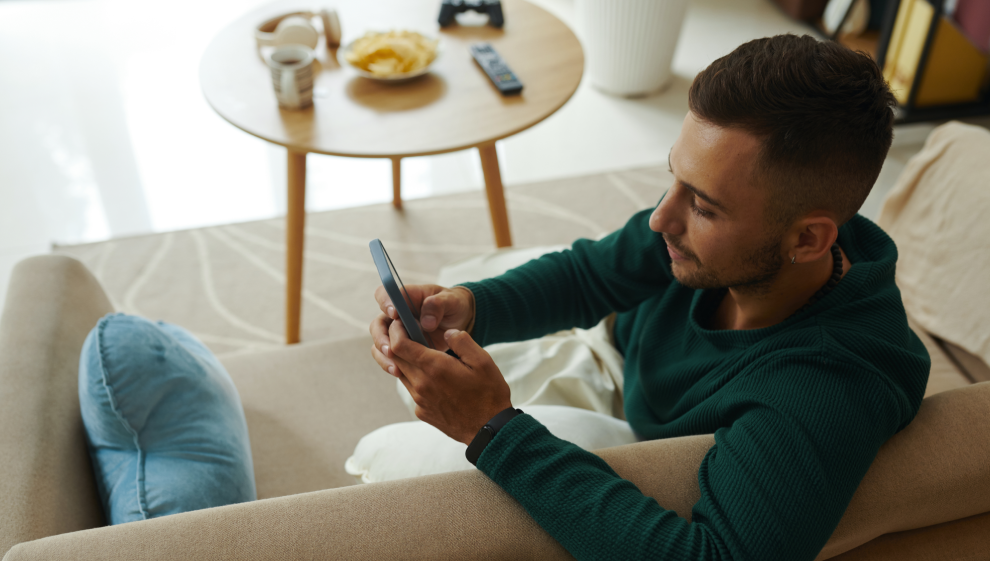What is ‘doomscrolling’ and how can I stop?
In this article, we explore what doomscrolling is, why it happens, and what you can do to avoid it.
Key takeaways
- ‘Doomscrolling’ is when we actively seek out distressing or negative material online
- The term can also describe the ‘aimless’ consumption of content
- It became more common during the COVID-19 pandemic
- It can negatively impact our mental health, sleep, and our interpersonal relationships
- For some, it can be an attempt to retain some degree of ‘control’ when things are frightening
- It can fuel negative behavioural patterns that are linked to smartphone addiction
What is doomscrolling?
Doomscrolling is when we actively seek out distressing or negative material online. This behaviour often leaves a person feeling distressed, anxious, or worried because they feel compelled to continue searching to avoid feeling oblivious or uninformed.
It also describes all the ‘aimless’ time we spend on our smartphones.
For example:
- Scrolling through reels or shorts without intent
- Checking apps to ‘box tick’ and feel ‘up to date’
- Reading comments sections
- Jumping between news apps to find alternative takes
- Checking emails aimlessly
- Constantly checking your push notifications
- Refreshing pages for updates
Why do we do it?
As humans, we are vigilant to potential threats and dangers. This can mean that over time, we develop a tendency to become curious about distressing news.
This news can trigger fear and anxiety, which are strong emotions that ‘hook’ us to make sure we keep coming back for more. People often feel compelled to keep checking for updates that alleviate their anxiety, even if it ultimately makes them feel worse.
When we feel ‘out of the loop’, we can feel like we have no say in what’s going on. The reality is, that even when we’re aware of what’s going on, we can’t do anything about it. This is why focusing on the things that we can change is such a powerful tool for combatting doomscrolling.
Why we keep engaging when it feels bad

While seeking out distressing (or even traumatic) content online may seem counterintuitive, it’s often driven by a desire to maintain some level of ‘control’ over events or information we find hard to process.
This is true regardless of how bad the news or certain content makes us feel. When an anxious response is triggered, we want to find something else online to confirm that everything is going to be okay, and the cycle begins all over again.
Other reasons why we continue to engage with content that makes us feel bad include:
- The fear of missing out (FOMO) on breaking news or important information
- Negativity bias
- Not wanting to appear uninformed on important topics and situations
- The need for control
- Searching for confirmation that everything will be okay
- The 24/7 news cycle means there’s always something new to fixate on
- Algorithms continue to give us more of the content we engage with
- ‘Echo chambers’ on social media feed us information that confirms our world view
How can it affect our mental health?
Doomscrolling can have a direct impact on our mental health.
When we go in search of ‘negative’ news, we are seeking out problems in the world that have the capacity to make us feel a certain way. By confirming our suspicions that there are problems all around us, we can end up feeling:
- Worried
- Scared
- Anxious
- On edge
- Fearful
- Stressed
- Desperate
- Helpless
- Isolated
Doomscrolling can also have a secondary impact on our mental health, by limiting the amount of good quality sleep we get and how confident we feel about engaging with more positive hobbies and friendships.
Taking on the problems of others
Empathy allows us to recognise the problems of others. Recognising that someone is going through something troubling or painful means we can react and help accordingly.
In today’s digital world, a lot of the problems we read or hear about are happening on the other side of the world, and while it’s good to educate ourselves and enact change where we can, many people find they take on the emotional burden when they can’t do anything to help.
Taking on the problems of others is sometimes called ‘vicarious trauma’. This describes the idea that we can read about a negative situation that someone else is in and ‘adopt’ the stress, worry, or anxiety ourselves despite not being directly involved.
How can it affect our sleep?
Many people find they start doomscrolling in bed at night. This is because a failure to immediately fall asleep leaves our brain in an unstimulated state, where it’s ‘looking’ for something to do.
If you regularly use your smartphone as a distraction throughout the day, your brain is simply doing what it’s been trained to do when you pick it up before bed. What’s additionally problematic is that when we look at our smartphone screen, we’re taking in blue light, which suppresses the production of the hormone melatonin which we need to sleep.
Looking at news that can provoke feelings of dread, worry, and anxiety is not conducive to healthy sleep. People who frequently worry often find that things get worse when they get into bed because they’re left ruminating over their day and all the problems in the world.
To help improve the quality of your sleep, try introducing some good ‘sleep hygiene’ techniques into your routine:
- Leave your smartphone in another room and use an old-style alarm clock instead
- Stop using your smartphone half an hour before you plan to sleep
- Avoid eating or drinking sugar before bed
- Introduce a dedicated period of mindfulness or meditation
- Go to bed at the same time every night
- Have a bath before bed
- Limit your light exposure before bed
- ‘Wind down’ and don’t get straight into bed after watching TV or playing video games
The link to smartphone addiction
While smartphones, tablets, computers, and other digital devices can be highly useful tools, compulsive use of these devices can start to disrupt work, school, and our interpersonal relationships.
Smartphone addiction, sometimes known as "nomophobia" (fear of being without a mobile phone), is often driven by internet overuse or internet addiction disorder. Typically, it's not the phone or tablet itself that causes the compulsion, but the games, apps, and online worlds they connect us to.
If you find yourself spending more time on social media or playing games than interacting with real people, it may be a sign that you need to reassess your relationship with your smartphone.
Alarming statistics around smartphone and social media use
Every year we publish our Healthier Nation Index report to get a detailed look at the health of the nation. A trend that comes up every year is the harmful relationship many of us have with our smartphones and social media.
- 22% of us are getting advice about health and fitness from social media
- 50% of us spend more than one hour per week on social media
- 30% of women admit to spending more than 3.5 hours a week looking at social media
- 21% of men admit to doing the same
- 26% of men say that social media has negatively impacted their physical or mental health in the last 12 months
Relationships and smartphone use

Doomscrolling and constantly spending time on your phone can lead to family, friends, and loved ones feeling isolated and underappreciated. It can appear like you’d rather spend time online than with them, and that whatever you’re looking at on your phone is more interesting than an authentic conversation or experience.
Others may find their partner or family member wants to share everything they do together online. This habit can detract from truly enjoying and appreciating moments that are special with loved ones. When everything is shared with the world, it becomes less of a personal moment between family and friends, and more something to show off or flaunt to followers online.
If this sounds familiar, try suggesting your friend or partner put their phone down during certain times of the day. For instance, limit your collective screen time during meals or while you’re catching up after work. You’ll find that conversations are more meaningful and that you’re both more present when listening to the thoughts, accomplishments, and concerns of the other person.
How can I stop doomscrolling?
Set clear boundaries
Start by designating specific times during the day to check your social media and news apps. Don’t be hard on yourself if you don’t stick to these at first, but try to make sure these windows are short and purposeful.
Avoid screen time at least an hour before bedtime to help promote better sleep and reduce anxiety. Also, consider setting physical boundaries, like keeping your phone out of reach when you’re spending time on other activities. Establishing clear parameters will help create a healthier relationship with online content and focus more on activities that you find fulfilling.
Track your behaviour
Monitoring your doomscrolling habits is crucial to understanding and reducing them.
Find an app that works for you or use a journal to record how much time you spend scrolling through negative news and social media. This data will ultimately help you identify the patterns and triggers that are causing this problematic cycle. By becoming more aware of your behaviour, you can start to set realistic goals aimed at gradually decreasing your screen time.
Tracking your progress also provides a sense of accomplishment and motivates you to stick with the healthier habits that form part of your new routine.
Engage with ‘positive’ content
Balancing your content consumption with uplifting and positive content is a powerful strategy to combat doomscrolling. Seek out articles, videos, and social media accounts that inspire, uplift, and entertain you, instead of outlets that anger, frustrate, or upset you.
Use your social media accounts to follow pages that share good news, personal development, or content about hobbies that interest you. After all, social media is meant to be a place where we engage with like-minded people who share our interests.
Be mindful of your triggers
Try to pay attention to the situations and emotions that are more likely to instigate a spiral of negative news consumption.
It could be stress, boredom, anger, frustration, or even specific social media trends. Once you identify these triggers, developing strategies to avoid or cope with them becomes a lot easier.
For instance, if boredom is a strong trigger for you, try to find alternative activities that benefit you mentally and physically, like exercise, reading a book, spending time with friends, going for a walk, or practising a hobby you’ve been neglecting.
How mindfulness and meditation can help
Life is full of distractions and it's not uncommon to start thinking about things that are outside of our control.
Thankfully, there are ways we can slowly ‘retrain’ our mind to focus better and limit the amount of time we spend fixating on things that aren’t immediately important. Mindfulness and meditation are two different techniques that can help us achieve this.
Mindfulness
Mindfulness is all about being present and not allowing your thoughts to distract you. When you’re mindful, you’re aware of your senses and what is happening in the here and now, not what has happened or what might happen in the future.
You can start when you’re at home or out for a walk. When you’re ready, start to observe the present moment as it is, without judgement or a desire to change it. Notice how your thoughts come and go and pull yourself back into the present if your mind starts to wander.
This might sound abstract at first, but over time this technique can help with the distraction and desire for control that are at the heart of our desire to seek out negative news and information. When you notice you’re ‘on edge’ or seeking control, focus on the present and what you can see, hear, taste, touch, and smell. Over time, this will become easier and easier and you’ll start to do it naturally.
Interested in finding out more? Click here to learn all about mindfulness
Meditation
When you are meditating, you are practising being mindful.
The two terms are often used interchangeably to describe a state of mind where our thoughts do not control or define us. The main difference is that meditation usually requires a specific environment where for us to sit and be still within, whereas ‘thinking mindfully’ can be done anywhere.
Taking time out of your day to sit and meditate is a great way to avoid spending too much time on your smartphone. Sit, be still, and let your thoughts wash over you. If you feel the urge to ‘be in the know’ or to ‘distract yourself’, accept that that’s how you’re feeling and that you can sit with those feelings and emotions without acting on them.
Over time, you’ll find that you turn to meditation not as something you feel you ‘have to do’, but as something you want to do because it makes you feel good.
Last updated Thursday 23 January 2025
First published on Tuesday 8 October 2024

